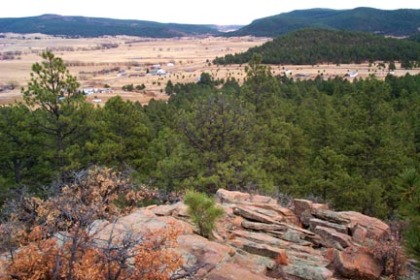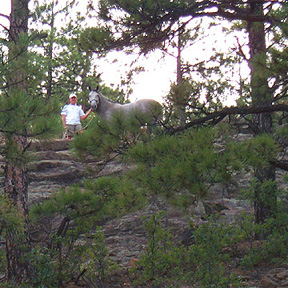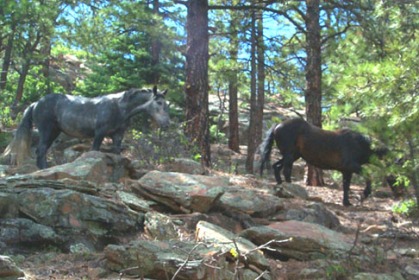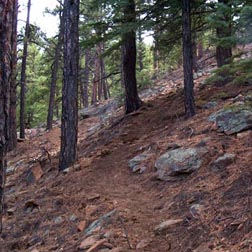Officially known as Star's Rest, our horses live on nine acres situated at about 7,600' elevation located in northeastern New Mexico. The land is mostly vertical and our friends like to tell us we would have thirty acres if we flattened it out. The photo below was taken from the top of a bluff known to the locals as Cougar Point. From this photo you can see the height we are above the valley.

Mike's mustang Cuervo, who is sadly no longer with us, was the first of our horses to forge trails to the top of this bluff and the other horses soon followed. Mike often used the bluff as a training ground for Cuervo teaching him the skills necessary for future mountain packing. After Cuervo's death, we renamed the bluff Cuervo Point in his honor and this photo was taken of him and Mike from the bottom of the bluff.

Our horses quickly began using the entire mountain for their adventures, often at a dead run. It's pretty breathtaking to watch three mustangs, one with very crooked front legs, fly across the face of a mountain that is difficult for me to walk on.

The upper portion of our land was very difficult to fence and trees are often blown down so I try to walk the fence line every other month or so, more often in wind and snow conditions. Walking the fence used to be a difficult and precarious job; but after a year the horses have created safe paths all over the property, even across areas where I once had to hang onto the fence to make sure I didn't tumble back down the bluff. Winding through the photo below is a mustang highway and to the right of the photo is the edge of the bluff seen in the photos above.

We have no pasture, our horses are fed free choice local grass hay and there is no reason for them to use the full extent of the property the way they do. Yet everyday they climb up the mountain on one side, browsing on shrubs and nibbling on small grasses, circle across the top, and then follow switchback trails back down. They not only do this in the daytime, I hear them heading up almost every night at around midnight. The downward switchback trails seem to be keeping back hooves in particular evenly worn across the heels which is usually a problem in domestic horses. The photo below shows a portion of one of the downward switchbacks.

The lower sandy portion of the property has become the social ground for our bachelor band. It is where they are fed and watered, where they nap in the sun, and where they come to play.

My plan for this journal is to create a category log for each of our horses to track their physical health and the changes in their hooves over time. I know our circumstances are unusual here and that we are starting with formerly wild horses who are particularly adapted to living in these conditions. But anyone who is familiar with adopted BLM mustangs is probably aware of how quickly those horses can deteriorate in domestic conditions. Because they have adapted to constant movement and poor forage, mustangs are particularly susceptible to insulin resistance and founder. Only one of our horses has ever worn shoes and his feet still show the effects of contracted heels and deep seated thrush. I will welcome comments and feedback and if you have your own story to tell, I'll be happy to put it on this blog in its own category.
April 27, 2006 at 4:59 pm
Boy oh boy am I envious! all we have is soft clay and a ton of water to make mud. Every time they put a hoof down a mini lake forms. I am in the process of getting bank run brought in and spread around so they will have a hard rock place that will be somewhat dry.
Great site!!! I am looking forward to visiting often to get more ideas.
Thanks,
Carolyn in Vermont
April 29, 2006 at 1:03 pm
What an amazing place! I assume you don’t need to do too much hoof trimming.
We have just had a fairly damp winter but at last the ground is drying out.
My son and I today laid 2 tonnes of stones round the gate and under the ash tree where the horses hang out here… just to try and get a little more natural abrasion.
You’re lucky on the foot account… however I am lucky in that we have grazing for all year and so top up feeding is minimal.
June 30, 2006 at 11:01 pm
A great site, very inspirational. Will check back periodically. My own “herd” is just two Morgans, and though they are never stalled (I don’t have a barn, just a three-sided shelter with half walls, where the horses are fed), they move very little until we take them out riding, or take them for walks, which we do 4-5 times a week, if not daily. They are both barefoot, but the mare needs boots for riding.
Previous years they’ve had grazing on approx. 2 acres of pasture during spring/summer/fall, but since learning that my mare was IR, I’ve had to limit that turnout to less than 1 hr per day, muzzled no less.
Good luck, and thanks for making this site available for the rest of us to learn from!
Brenda in BC
December 14, 2006 at 1:40 am
Gorgeous. I would love to see your mustangs romping there. We are in process of putting in our own Paddock Paradise and we are so excited. It makes a lot of sense to us and the place we board is offering to experiment–how cool is that!! We think there are about 2 acres or less with woods and a bit of pasture and a pond. The track will wend through the woods, but we are hoping we have enough space for 6 horses. Any feedback? Will keep you posted.
February 24, 2007 at 5:16 pm
Your horses are very lucky!
I’ve just received Paddock Paradise and am just starting to formulate plans to re-do my pastures. I have about 5 acres to work with…but just flat without any gorgeous scenary like this! Other than a new development of houses next to our farm.
Just checking out any websites I can find to get ideas. I have an IR Morgan with laminitis that has lead me on a search for a better life for him. Also another Morgan and a young Percheron/Arab cross filly who will also benefit from this concept I am sure.
Thanks for sharing your photos. Will check back for your updates!
Pat Schwartz
Stacy, Minnesota
May 17, 2007 at 4:08 am
Got our track done and the horses seem to like it. Stone and rock is good for their feet and the pond water makes our life easier. Wish we had more space but they do seem to be moving a good bit, though they tend to congregate at the gate (still getting grain there). Have another muddy spot but have never seen them roll there.
June 17, 2007 at 4:33 am
My husband and I are both professional farriers. We are also fond of feral mustangs and have had the opportunity to work on quite a few. We have also noted their susceptibility to laminitis. Insulin resistance is also an interesting point to ponder as far as feral equines are concerned. By the way, only one of the mustangs we work with is shod – and only for brief periods. We do not encourage shoeing for the others.
I was browsing through your site and noticed your section on advice to folks getting started in trimming. You had some good points. I might add a few to that. As far as being a woman and not feeling confident charging enough – malarky. I’m a female farrier. Do not start off underpaying yourself. This is a big mistake many farriers make. At the very least, you will be the unhappy recipient of every rank horse and cheap-skate owner for 50 miles. To many of them, it won’t matter whether you provide an actual barefoot trim or not. They want a cheap trim and will take advantage of you. You will probably get physically injured in the process of dealing with their horses – and get a rep as the “cheap rank-horse trimmer”. Charge what is reasonable in your area for the service you provide. Your sex has nothing to do with it. You sweat just as hard as a man.
As far as clicker training, I have seen some horses on whom this method has worked well. These were very people oriented/trainer friendly horses. However, in the last 4 – 5 years we have worked on a number of susposedly clicker trained horses and have found them to be the worst behaved ones in the bunch. Some of this is likely due to less-than-optimal training which has left the horse with the idea that the handler is a clicking food vending machine. Be aware of this possibility, it has gotten folks hurt. When the clicking and/or the snacks stop, the horses have invariably acted out. Most of the time the farrier/trimmer bears the brunt of this behavior. In short, if someone claims to have a clicker trained horse (or any other specialty training for that matter) believe it when you see it. Don’t trust any horse to stand perfectly based on any sort of training. I know this sounds cynical, but we have worked on anywhere from 2 to 17 horses a day. Don’t risk your life by trusting any technique too much.
Oddly enough, my guess would be that most farriers would like to do as much trimming as possible. Speaking solely in terms of economics, you make more money in a shorter time. In the time it takes to fully shoe one horse, you could have properly trimmed 4 to 6 and made at least $80 more — with no inventory coming off your truck.
As far as the barefoot trimming techniques versus standard trimming techniques taught in most reputable farrier schools — you might be surprised. We were taught the “mustang roll” for barefoot trims – although it was not termed that. Most professionally trained farriers also take hoof flares back in the same manner as the barefoot method. As far as cleaning up the frogs, very little (if any) difference there. As far as our business, we do not encourage shoeing on any horses unless the owner insists on it or there is reasonable cause to shoe. For example, wear exceeds growth and shoeing alternatives are not viable.
You voiced concerns about farriers feeling threatened. I don’t think too many professional farriers will feel threatened by barefoot trimmers. I also don’t think they will try to push you out of business. From what we have observed, folks are either barefoot enthusiasts or they aren’t. There will be enough work to go around I’m sure.
On the subject of mustangs again – natural selection has provided them with the hooves they need to survive. If they didn’t have the feet to carry them, they wouldn’t have survived and neither would their genes. Nature doesn’t generally allow unsoundness to go too far. Mustangs have not had people monkeying around with them, breeding for everything BUT sound feet. In some of today’s domestic breeds, selection for decent strong hooves has gone by the wayside in favor of color, gait, shape of head etc etc etc. It’s our opinion and observation that genetics do count for something and weak footed parents often produce weak footed offspring. We have often debated, given this perspective, if it is appropriate to make the feral mustang the example when trimming domestic horses that have not had the same selective pressures acting upon them.
Just the odd 2 cents worth (or more)
Cheers,
Michelle Smith
Oregon
June 17, 2007 at 12:41 pm
Hi Michelle – I think you must have me confused with someone else. Other than the fact we have mustangs and have used clicker training in a limited way, I have never written or posted about most of the things you are commenting on. I have no problem with publishing your comment; but you might be better served posting it to the person you really intended the comment to go to. Carmon Deyo – blog owner
June 17, 2007 at 11:54 pm
Hello Carmon,
I was commenting on a couple of articles posted under the “Barefoot For Soundness” heading on your sidebar. I thought this area was a discussion area for folks browsing articles and such on the blog/site. Apparently my mistake. Sorry about that.
Michelle
January 12, 2009 at 12:43 am
Just wondering of anyone has had issues with injury or fighting on the track? I am desperately trying to persuade the owners where I board to let me try it. However they feel the horses will get stuck in such a “confined” area and will go through the wire fence because they can’t get away. Has anyone seen this? I don’t think it would be a problem I have 3 horses 2 docile geldings one pushy & dominant mare. I would think that they would just move on the track and they would be so busy there would be less fighting/dominace issues ect. any points would be appreciated Holli
September 2, 2009 at 12:49 pm
What a fun environment! They are probably so happy to have the freedom to roam like they do, it sure seems like they know what they’re doing. I hope everything works out for you and your mustangs!
March 17, 2010 at 11:24 pm
Hi all, well we are finally in the positon of setting up our own track paradise ( on our own property) after unsatisfactory rental grazing, sick horses and a whole lot more frustrating things.
One of our lane ways is constricted far more than advisable due to the placement of the house and boundary and as it is access to water as well, so we can’t change it. We have two dominanat horses,(snots!) and two placide ones.
As the article states constrictions keeps them moving, the two snots even allow each other to back up if required and then turn around absoultey no fighting at all. They leave their snot attacks to the wider spaces allowing the other placide horses to move out of the way.
Loving having happy, mentally and emotionally stable horses, who are barefoot sound and constantly moving. We have here in New Zealand have our own Kaimanawa wild horses, who are captured once a year and sold on. Thye have exzactly the same probelms as domesticated mustangs…no more pleased to say… as one is my daughters beloved buddy.
Great to have pioneers go before us and perfect things for us, thanks folks. 🙂
Here in kiwi-land there are many who are using this system and loving it.
You have one hundred percent support from your southern cousins 🙂
Keep up the good work.. thanks folks.